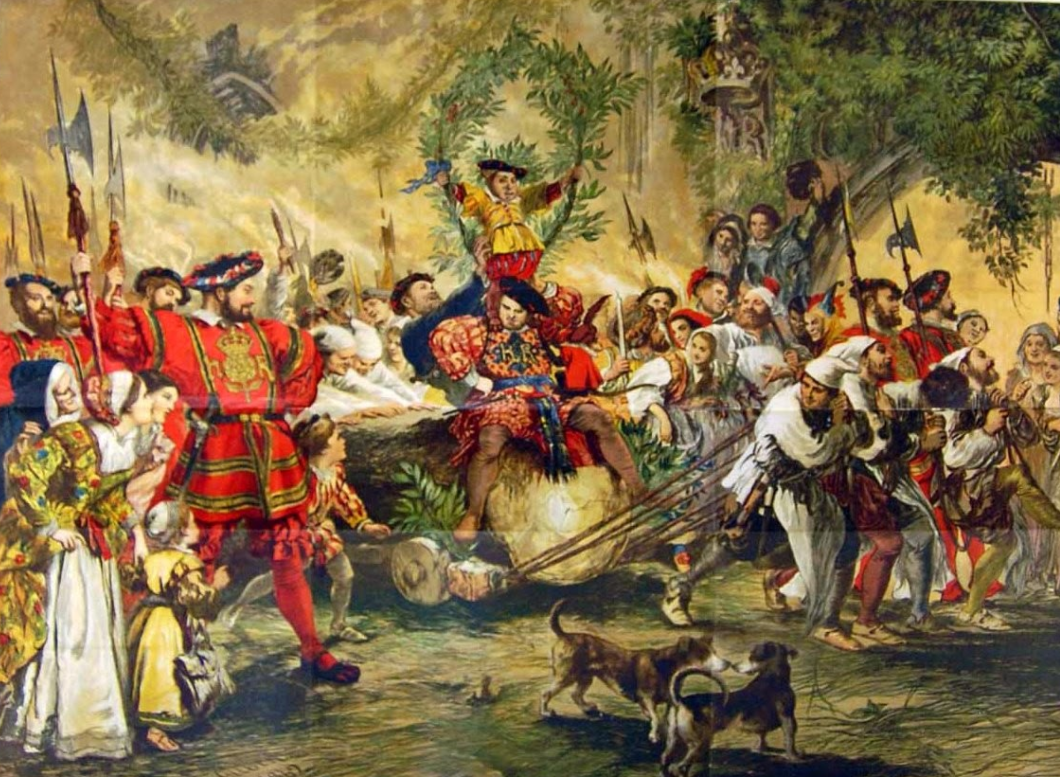So now is come our joyful’st feast,
Let every man be jolly.
Each room with ivy leaves is drest,
And every post with holly.
Though some churls at our mirth repine,
Round your foreheads garlands twine,
Drown sorrow in a cup of wine,
And let us all be merry.
–George Wither (1588-1667)
It’s December 21st, the day of the Winter Solstice; also the longest night of the year, when the Earth is tilted the furthest angle away from the sun. From here, we look forward to the days getting progressively longer until the summer solstice arrives.
So what does it mean? Why is it celebrated? And what’s a “yule”, anyway?

Until the 16th century, the winter months were a time of famine in northern Europe. Most cattle were slaughtered so that they wouldn’t have to be fed during the winter, making the solstice a time when fresh meat was plentiful. Most celebrations of the winter solstice in Europe involved merriment and feasting. In pre-Christian Scandinavia, the Feast of Juul, or Yule, lasted for 12 days celebrating the rebirth of the sun and giving rise to the custom of burning a Yule log.
There are three main theories about Yule (Danish/Norwegian/Swedish: Jul / Old Norse: Jól). The first theory describes Yule or Jól (pronounciation: “yoh-l”) as a celebration for the return of the sun. The second theory talks about Yule as a midwinter party for the dead. The third theory describes Yule as a fertility feast, where people would sacrifice animals to the Gods, in the hopes of getting a good harvest in the coming year. Since Yule is about several parties and not just one, all three theories could, in theory, be true.
Today, in many Nordic countries Yule is another word for Christmas, and the connections between the two are made clear thorough the resilience of certain customs, activities, and decor, like singing carols, making a Christmas ham, and one of the most important customs of the holiday: burning the Yule log. Originally, the ceremony involved burning an entire tree and then bringing the remaining trunk or branches indoors to continue burning over twelve nights. Today, you can incorporate it into your decor by creating a wreath with a branch, hollowing out a log and filling it with other relevant Yule decor, or displaying some firewood.
So how was the Yule and Christmas celebrated in Elizabethan England?
Hospitality is the rule. All who can do so furnish their tables with all the meats, marchpanes, pies, custards, and so on that they can afford, and more.
Entertainments in the season include mummer’s plays of various kinds, often incorporating music and morris dancing (also performed at May Day). The story of St. George and the Dragon is especially popular. Morris dancers are regularly invited to perform at Court. Such entertainments are meant for the whole manor or household, including tenants; the whole village; or the whole Court.
The Queen kept Christmas most often at Greenwich Palace, which is relatively small. Alternate locations in certain years are Hampton Court (in 1568 and 1579) and Nonesuch Palace. Court festivities, as at other times, include dancing, gambling, and plays.
The decorations about any house include holly, ivy, box, yew, bay, laurel, holm oak, and in fact, anything still green. Both church records and household accounts show money spent for holly and ivy to be brought in for the holiday. In the church itself, along with the greenery, a wooden figure of the Christ Child sometimes rests on the altar. The “nativity scene” hasn’t come to England from Italy yet.
Mistletoe grows only on oak and apple trees. It isn’t mentioned in a Christmas context before 1622, at which time it seems a fond custom, not newly introduced, but we can’t tell how far back its use in England goes, or if it was regional, or what. If it was common, it should be easy to find. Kissing under the mistletoe was not traditional, even in 1622.
The young men of the household go out on Christmas Eve and dress (trim) a log or block of wood from the central trunk of a tree specially chosen for the purpose. They drag it into the fireplace in the hall, where it is lit with a bit saved from last year’s log, and is expected to burn all night.
Sensible people save pieces from the Christmas log through the next year to protect the house from fire.
The most popular Christmas dinner is brawn (roast pork) with mustard or roast beef. Also popular are mince pies, frumenty, plum porridge, and a Christmas pie of neat’s tongue, eggs, sugar, lemon & orange peel, spices.
Good husband and huswife, now chiefly be glad,
Things handsome to have, as they ought to be had.
They both do provide, against Christmas do come,
To welcome their neighbors, good cheer to have some.
Good bread and good drink, a good fire in the hall,
Brawn, pudding, and souse, and good mustard withal.
Beef, mutton, and pork, and good pies of the best,
Pig, veal, goose, and capon, and turkey well drest,
Cheese, apples and nuts, and good carols to hear,
As then in the country is counted good cheer.
What cost to good husband, is any of this?
Good household provision only it is:
Of other the like, I do leave out a many,
That costeth the husband never a penny.
–Thomas Tusser, 500 Points of Husbandry, 1573
